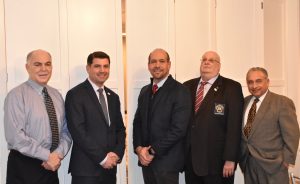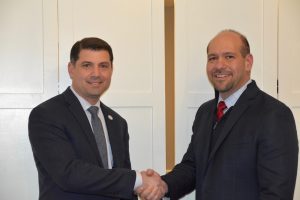Industry Expert James Neri Addresses Nassau Suffolk Water Commissioners’ Association
Pinhole leaks have been a problem across the nation, and Long Island is no exception to these unfortunate events. At a recent Nassau Suffolk Water Commissioners’ Association (NSWCA) meeting the Association received a case history presentation regarding pinhole leaks, and the remedies used to fix the annoying and potentially costly problems. Guest speaker James L. Neri, Vice President, H2M Architects & Engineers (Melville, NY) combined in depth background information with real life solutions in a detailed case history.

After extensive research and discussions with industry experts, Mr. Neri noted, “the water supplier had recently added Packed Tower Aeration on 66% of their production capacity and the utilization of post tower pH adjustment, decreased the alkalinity of the finished water. This minimized the passivating layer of calcium oxide, thereby allowing pitting of the piping. The increase in alkalinity help to create a passive layer between the water and the copper piping.”
L to R: NSWCA second VP Kenneth P. Wenthen Jr., West Hempstead Water District; NSWCA President Michael F. Rich III,Oyster Bay Water District; James Neri H2M; NSWCA first VP William Schuckmann Hicksville Water District; NSWCA Treasurer Lawrence Zaino Jr., Carle Place Water District.
Mr. Neri further explained that in this case “the persistent problem was addressed with an alkalinity adjustment. Wells with packed tower aeration were modified to maximize alkalinity and in total, seven wells on four sites were modified. Pinhole reports have dropped dramatically.”
 NSWCA President and Oyster Bay Water Commissioner Michael F. Rich III. “Pinhole leaks have been a recurring problem across the USA. Several very important takeaways from Mr. Neri’s case history include the recognition that communication is essential to getting a workable solution in place. Even sporadic customer calls should never be underestimated, and active public outreach with homeowners and elected officials can help get to the core of the potential problems faster. We thank Mr. Neri for his very informative presentation.”
NSWCA President and Oyster Bay Water Commissioner Michael F. Rich III. “Pinhole leaks have been a recurring problem across the USA. Several very important takeaways from Mr. Neri’s case history include the recognition that communication is essential to getting a workable solution in place. Even sporadic customer calls should never be underestimated, and active public outreach with homeowners and elected officials can help get to the core of the potential problems faster. We thank Mr. Neri for his very informative presentation.”
Michael F. Rich III (left) and James Neri
